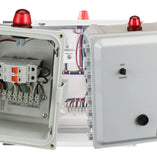Call: (936)-681-8198
(936)-681-8198

Key Features Specs Warranty The time controls what time The most common application is to control the time when the sprinklers come on as mand...
View full detailsKey Features Specs Warranty The time controls what time The most common application is to control the time when the sprinklers come on as man...
View full detailsControl panels are designed to monitor every part of your treatment system, also offering you complete control over it for regular usage or maintenance purposes. There are a few key parts that make up the system as a whole.
The panels themselves house the controls over your septic system. These include power for the air and water pumps as well as pump failure indicators. Other types of pump systems may require simplex or duplex control panels, which monitor a set of one or two submersible pumps. For these systems, an alarm will notify you in the event of high water or a tripped fuse. There are several time-dosing control panels that regulate water usage during peak times. They use cycle timers to distribute water across both primary and secondary systems.
A control panel is basically a breaker box with a few extra features. Control panels will typically be used to control water/sewage pumps and air compressors. Control panels will often have an alarm attached to them to indicate if a problem has developed. The most common places you will find control panels will be in lift stations or on septic systems.
Septic systems are becoming more complicated. There has become a need for a device to manage all of the electrical components. This is where the control panel comes into play. The control panel is essentially a breaker box for a septic system. There will usually be a few electrical circuits in a septic system, and the control box will help the user control and monitor those circuits.
Aerobic control panels are commonly found on aerobic septic systems. These systems need to keep track of air pressure and water level in the septic system. This is accomplished by using a pressure switch and float switches. The pressure switch will trigger an alarm if there is a loss in air pressure. The float switches are used to turn on and off an effluent pump and an alarm. The diagram below will show a basic setup for an aerobic control panel.
Basic aerobic control panel connections

There will be some control panels that use timers. This is because some septic systems use sprinklers to disperse the wastewater. Homeowners that have sprinkler systems may not want their sprinklers spraying them while they are in their yard. A timer in a control panel will tell the pump when it can activate. This allows the homeowner to make sure that the sprinklers only activate during times that they are not in their yard.
A control panel with a timer will usually use more float switches than a control panel without a timer. This is because there will usually be an override float switch in a timed system. This allows the systems to know if too much fluid has built up during non-pumping hours. The pump will activate at any time the override float switch activates. The figure below shows the basic setup for a control panel with a timer.
Basic aerobic control panel with timer connections

Lift station control panels
A lift station is a facility that collects water or wastewater and pumps it to another location. These stations are used when there is not enough of an incline for gravity to move the wastewater. This generally occurs when a neighborhood is far away from a wastewater treatment plant. Water or sewage pumps are used to move the wastewater the extra distance.
The lift station itself will have a collection tank for the wastewater and pumps to move the wastewater. The pumps will be attached to float switches or another device to track the fluid level. The float switches will activate the pumps when the wastewater reaches a particular height. This allows the pumps to turn themselves on and off without someone constantly watching them.
These float switches will work in the same way as float switches in septic system. There will often be a float switch to turn on and off the pump and another float for a high-water alarm. The figure below shows the basic configuration of a lift station control panel.
Basic Simplex control panel

$100.00 away from free shipping!
